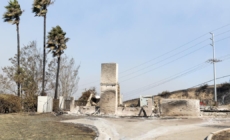-
Fans Want Donald Trump to Change Commanders Back to Redskins After Winning Presidency - 18 mins ago
-
3 people arrested and charged in connection with Liam Payne’s death, Argentinian authorities say - 20 mins ago
-
Metrolink CEO’s home is among those destroyed in Mountain fire - 24 mins ago
-
Kamala Harris supporter Sally Field trashes campaign sign after Donald Trump victory - 29 mins ago
-
2024 College Football Week 11 action report: ‘Impressive’ Indiana is ‘public darling’ - 36 mins ago
-
Fed Chair Jerome Powell says he won’t resign if Donald Trump asks him to step down - 38 mins ago
-
Adam Fravel convicted of suffocating, killing ex Madeline Kingsbury, hiding her body - 43 mins ago
-
Austin Hill Reveals Biggest Challenge At Phoenix NASCAR Xfinity Race: ‘Got to be Prepared’ - about 1 hour ago
-
Machine guns, child pornography lead to charges against O.C. man - about 1 hour ago
-
Zelenskyy says Europe needs strong U.S. under Trump - about 1 hour ago
Tornado insurance coverage is real — but watch for loopholes
In aftermath of the deadly tornadoes that ripped across parts of the Midwest and South this week, homeowners may rightfully be nervous about whether they are financially protected against potentially devastating storms.
The last three years have had the highest insured losses on record from natural disasters, according to a recent report from Aon. Tornadoes are just one of the severe weather events that can destroy or damage property. Some 1,200 of them hit the U.S. yearly, and the phenomenon has been reported in all 50 states.
A recent study suggests that these storms may be occurring more frequently because of global warming, as well as shifting eastward toward the densely populated Southern states of Alabama, Mississippi and Tennessee.
Before a storm strikes, there are steps homeowners or renters might take to make sure they’re financially protected tornadoes.
Homeowners insurance should have you covered
Wind damage, including that from tornadoes, thunderstorms and straight-line winds known as “derechos,” is covered as part of a standard homeowner’s policy.
“Tornado coverage is not a separate policy that you need coverage for — it’s covered in your standard policy,” said Karen Collins, vice president of property and environmental at the American Property Casualty Insurance Association (APCIA), an industry group.
Review your homeowner’s policy. One of the first few pages, titled “declarations,” will list your coverage limits and how much money you might collect in a claim. Covered items include reconstruction costs, as well as replacement of destroyed belongings inside your house — referred to as “contents coverage” or “personal property coverage,” Collins said. There should also be coverage for your living expenses, such as a hotel, if you need to relocate while your house is being repaired.
What are the deductibles?
Most homeowners insurance policies come with a deductible — a certain amount of money you need to pay for repairs before your coverage kicks in. You might have a flat deductible or, as is becoming more common, the policy might specify different deductibles for certain situations.
“In a lot of areas, insurers have put wind deductibles in place,” said Amy Bach, executive director of United Policyholders, an advocacy group for insurance consumers. “Some of them will have wind velocity clauses, where if the wind gets to a certain speed the deductible applies.”
Often, instead of being represented as a dollar amount, the wind deductible will be expressed as a percentage of the whole policy — that can amount to a significant sum.
“Those deductibles are a bigger chunk of change than they used to be,” Bach said.
She advises getting on the phone with your insurance company before a potential disaster to walk through your policy.
“You want to know, ‘Do I have a wind deductible?’ and ‘Can I buy a policy that has a lower deductible or has a flat deductible?’ That’s a little better,” she said.
Actual costs or replacement costs?
An insurance policy will cover your belongings for either their actual value or their replacement cost — for example, the price of new furniture, rugs and any appliances you may need to buy if your current home is destroyed.
Think of it this way: Your 12-year-old sofa may only be worth $500 on the market, but if your belongings are destroyed and you need to replace it, you could shell out $2,000 or more for a new couch.
For that reason, replacement-value policies tend to be more expensive, but they can also save you some hassle. This type of policy could make even more sense today, as the price of home furnishings has skyrocketed in recent years.
Think about flooding — even outside the flood zone
During most tornadoes, flooding isn’t an issue, which is a good thing given that floods require dedicated flood insurance.
Water damage coming from above, on the other hand, should be covered by a standard policy, said Loretta Worters, spokesperson for the Information Insurance Institute.
“Flooding is considered a rising body of water, so if it’s coming from the ground up, you would not have coverage,” she said. However, if a tornado tears off part of your roof and your house is damaged by rain, that should be “a covered peril,” she said.
Still, homeowners should consider additional flood coverage if they live in a low-lying area, or somewhere that gets heavy rains. With climate change making precipitation more intense, many places are experiencing flooding for the first time. A severe storm that causes tornadoes could also create flash floods.
Bach also noted that insurance companies have become more aggressive about defining certain types of water damage as flooding — such as when a storm damages part of the house’s sewage system and water backs up into the house — and refusing to cover it. That’s a possible scenario that you should run through with your insurance company, she said.
“Before you have a loss, call your insurance company and get sewer-and-drain backup coverage,” she said. “If you have a sump pump, ask them if it’s covered if the sump pump fails.”
Such coverage is usually available as an add-on, or “endorsement” in industry language.
Renters insurance: Necessary, and fairly cheap
If you rent, it may be wise to purchase a separate renters insurance policy, which should cover your belongings in a range of scenarios — storms, break-ins or other unexpected events.
A homeowner’s policy will cover the owner’s stuff, but your landlord’s policy won’t extend to your belongings. Renters insurance often also covers temporary lodging if you have to leave your home in a disaster.
“It’s a couple hundred dollars a year, and it makes a big difference,” Worters said.
Home office? You may need an additional policy
If you have a side gig or a home office that you use for work, make sure it’s explicitly protected if a storm strikes. This could mean getting an add-on for your insurance policy from your home insurer.
“Most homeowners’ policies will have a cap on business property, and it’s something like $1,500, $2,500. So if you have more than that, you’re out of luck,” Bach said.
You could also take out separate business coverage, which will protect your side gig from liability if you run into legal problems, like being sued by a disgruntled customer or bystander.
Think about your car
If you have a car, consider shelling out for additional coverage in the case of a disaster. Non-driving damage is covered only under a “comprehensive” policy, colloquially known as “full coverage.”
“If you have debris that falls on the car, or hail or even flooding, that’s covered under a comprehensive policy,” said Collins of the APCIA. “And if you need to be in another vehicle while [yours is] being repaired, you’ll have a little bit of coverage for that as well.”






























